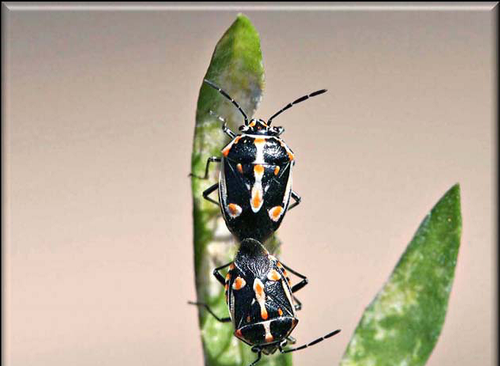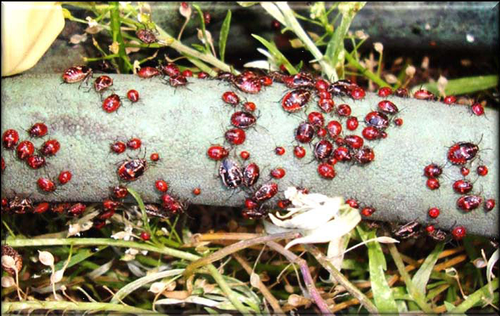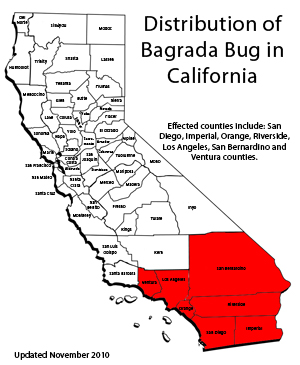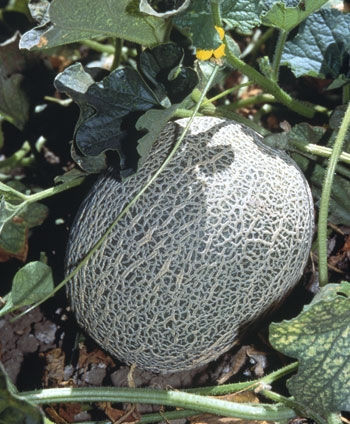From the UC Blogosphere...
Bagrada Bug Now Found in Southern California
In a recent newsletter of the Western Plant Diagnostic Network, (WPDN) for First Detectors, a new pest of California was highlighted. This pest is the Bagrada Bug, Bagrada hilaris, Burmester 1835, Order Hemiptera, family Pentatomidae. Following is the text and a few pictures from the newsletter. The article was written by Richard, Hoenisch, Editor of WPDN First Detector Network.
The Bagrada Bug is a species of shield bug known by the common names bagrada bug, painted bug, and harlequin bug. It is native to much of eastern and southern Africa and parts of southern Europe and Asia. It is now known in CA and AZ, where it was first reported in 2008. It is a major pest insect of Brassica oleracea crops, including cabbage, kale, cauliflower, Brussels sprouts, and broccoli, and related crucifers such as turnips, rape, and mustard. The adult and nymph of the species suck sap from the leaves of the plants, causing wilting, yellowing, and stunting of growth. Please see The Bagrada bug, a New Invasive Pest of Cole Crops in Arizona for a view of the damage. Besides crucifers, the bugs are known on papaya, sorghum, maize, potato, cotton, caper, pearl millet, and some legumes. Large numbers of the bug congregate on the plants and cause extensive damage. The adult bug is 5 to 7 millimeters in length, shield-shaped, and black with white and orange markings. The female, which is larger than the male, lays up to 100 oval or barrel-shaped eggs on leaves or in soil beneath plants. The eggs are white when freshly deposited and turn orange over time. Within 8 days the first-instar nymph emerges. It is bright orange-red and turns darker as it develops, becoming mostly or predominantly black by the last instar. The bug made a sudden appearance in Los Angeles in June, 2008, its first sighting in the Western Hemisphere. It then moved into the cropland of the heavily agricultural Coachella and Imperial Valleys of California, doing damage to cole crops there, especially those grown organically. Dr. Gevork Arakelian, entomologist for Los Angeles County, says this insect has the potential to become a very serious pest.
Colorado cantaloupe listeria outbreak affects California growers
The Colorado farm linked to a deadly listeria outbreak last fall is 1,300 miles away, but the tragedy changed a way of life in Mendota, Calif., the Central Valley farm town that proudly calls itself the Cantaloupe Center of the World, said an article in the Los Angeles Times by Diana Marcum.
This would normally be the season when farmers plan the summer crop that in good years is valued at nearly $200 million, according to the California Cantaloupe Advisory Board. Instead, they are cutting acreage and scrambling for ways to reassure a nervous public that cantaloupes are safe to eat.
This month the UC Center for Produce Safety will host a closed-door symposium in San Diego for cantaloupe growers, shippers, agricultural researchers, government regulators and others to create guidelines for best growing practices.
"The main question will be, 'What are the gaps in our knowledge?'" said Bonnie Fernandez-Fenaroli, executive director of the UC Davis-based center. "Do we need to do research or is it a matter of the cantaloupe industry implementing and enforcing best practices?"
UCCE director in Tulare County takes Kings County reins
Lewis Griswald, Fresno Bee News Blog
Tulare County UC Cooperative Extension Director Jim Sullins will also be director of the Kings County UCCE office. Longtime Kings County UCCE director and 4-H youth advisor Peggy Gregory retired at the end of the year. She served 37 years with the University, including 20 in Kings County.
Grape growers fend off thieves, pests
Fresno Business Journal
Pests and thieves can cost grape growers a great deal of money and headaches. That’s why the two issues were addressed along with other important topics at the UC Cooperative Extension San Joaquin Valley Grape Symposium held Wednesday in Easton.
UCCE viticulture farm advisor Stephen Vasquez gave an update on glassy-winged sharpshooters and Pierce's disease. He said that recent catches of sharpshooters are concerning since they have been found near a major riparian corridor that has had a historically low level of Pierce’s disease.
Love in the Fava Beans
It was lovely day today, in more ways than one.During the lunch hour, we stopped by the Häagen-Dazs Honey Bee Haven on Bee...
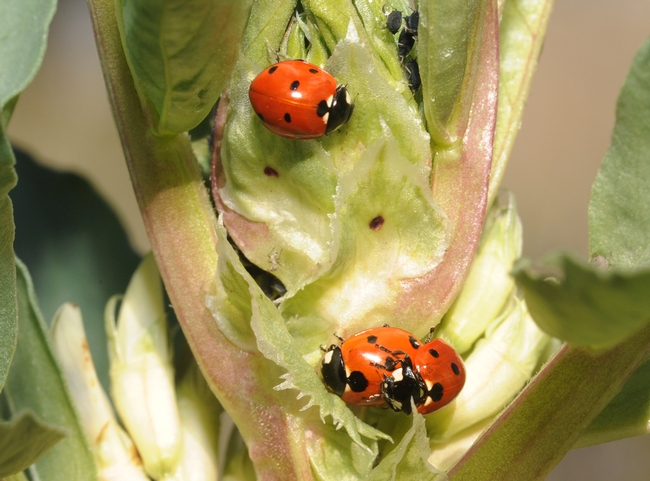
Ladybugs in the fava beans at the Haagen-Dazs Honey Bee Haven. (Photo by Kathy Keatley Garvey)
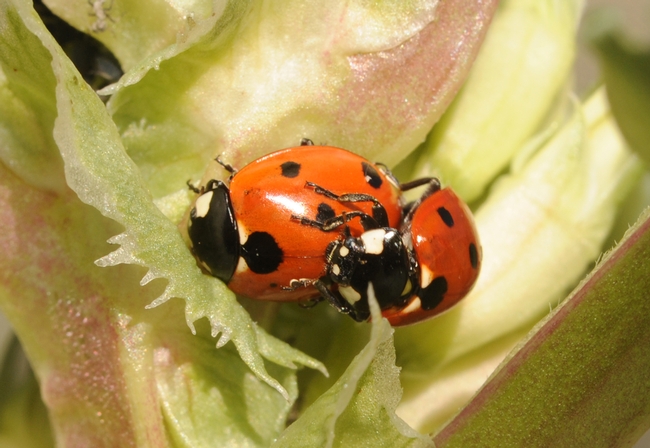
Soon the Haagen-Dazs Honey Bee Haven will have a new generation of ladybugs. (Photo by Kathy Keatley Garvey)
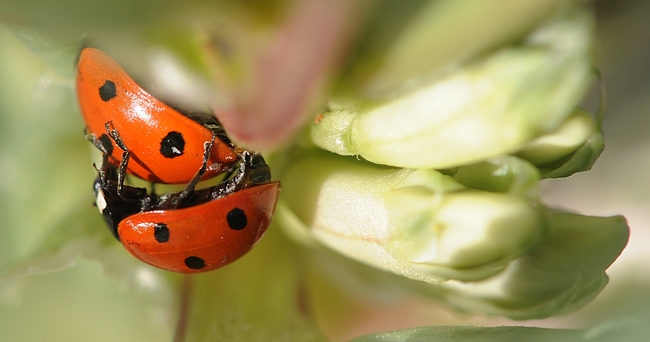
Ladybugs doing what comes naturally. Fava bean blossoms are at the right. (Photo by Kathy Keatley Garvey)
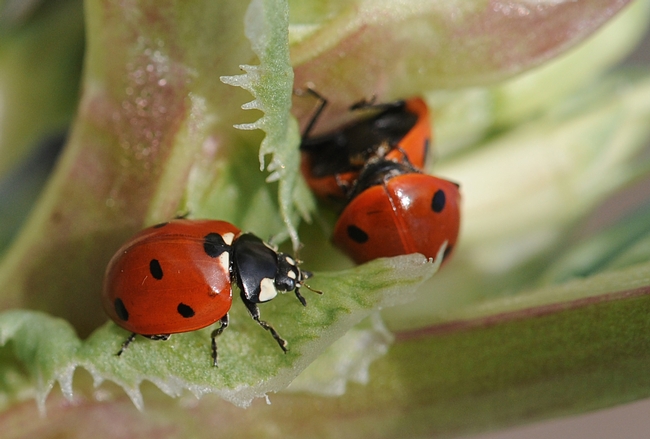
A sole ladybug, aka lady beetle, crawls past a pair of the beetles. (Photo by Kathy Keatley Garvey)
California Report features UCCE biocontrol scientist
The public radio daily magazine program The California Report this morning featured a three-minute interview with UC Cooperative Extension biological control specialist Mark Hoddle. The interview-format story comes a day before the release of Asian citrus psyllid natural enemy Tamarixia radiata in Los Angeles County neighborhoods. Hoddle and his wife Christina Hoddle, an assistant specialist in entomology, had collected colonies of the parasitoid in the Punjab region of Pakistan.
Reporter Rachael Myrow told listeners the release of natural enemies on Friday is the first major release in a major urban area, and then allowed Hoddle to explain the developments and their implications.
For more on Tamarixia radiata, see the UC ANR press release.
Myrow also posted a story on newsfix, KQED's Bay Area news blog.
On the Fly
We've been waiting with bated breath for butterfly expert Art Shapiro, professor of evolution and ecology at UC Davis, to...
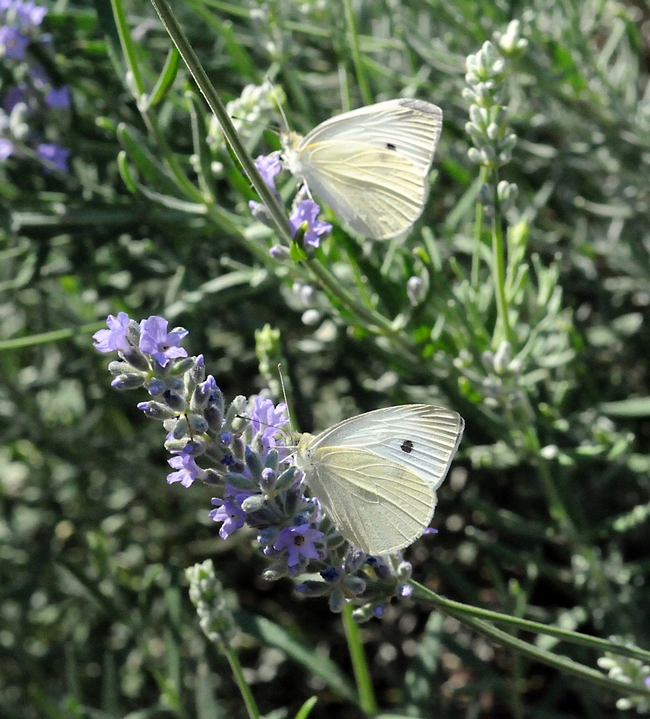
Two cabbage whites (Pieris rapae) on catmint in Vacaville, Calif., on Sept. 7, 2008. (Photo by Kathy Keatley Garvey)



